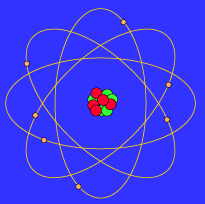Balancing Redox Reactions Using the Half Reaction Method
Many redox reactions occur in aqueous solutions or suspensions. In this medium most of the reactants and products exist as charged species (ions) and their reaction is often affected by the pH of the medium. The following provides examples of how these equations may be balanced systematically. The method that is used is called the ion-electron or "half-reaction" method.
Example 1 -- Balancing Redox Reactions Which Occur in Acidic Solution
Organic compounds, called alcohols, are readily oxidized by acidic solutions of dichromate ions. The following reaction, written in net ionic form, records this change. The oxidation states of each atom in each compound is listed in order to identify the species that are oxidized and reduced, respectively.

An examination of the oxidation states, indicates that carbon is being oxidized, and chromium, is being reduced. To balance the equation, use the following steps:
1. First, divide the equation into two halves; an oxidation half-reaction and reduction half- reaction by grouping appropriate species.
2. (red.) (Cr2O7)-2 ----> Cr+3
3.
(ox.) C2H6O ----> C2H4O
4. Second, if necessary, balance both equations by inspection. In doing this ignore any oxygen and hydrogen atoms in the formula units. In other words, balance the non-hydrogen and non-oxygen atoms only. By following this guideline in the example above, only the reduction half-reaction needs to be balanced by placing the coefficient, 2 , in front of Cr+3 as shown below.
5. (red.) (Cr2O7)-2 ----> 2 Cr+3
6.
(ox.) C2H6O ----> C2H4O
(as there are equal numbers of carbon atoms on both sides of this equation, skip this step for this half-reaction. Remember, in this step, one concentrates on balancing only non-hydrogen and non-oxygen atoms)
7. The third step involves balancing oxygen atoms. To do this, one must use water (H2O) molecules. Use 1 molecule of water for each oxygen atom that needs to be balanced. Add the appropriate number of water molecules to that side of the equation required to balance the oxygen atoms as shown below.
8. (red.) (Cr2O7)-2 ----> 2 Cr+3 + 7 H2O
9.
(ox.) C2H6O ----> C2H4O
(as there are equal numbers of oxygen atoms, skip this step for this half-reaction)
10. The fourth step involves balancing the hydrogen atoms. To do this one must use hydrogen ions (H+). Use one (1) H+ ion for every hydrogen atom that needs to balanced. Add the appropriate number of hydrogen ions to that side of the equation required to balance the hydrogen atoms as shown below
(red.) 14 H+ + (Cr2O7)-2 ---> 2 Cr+3 + 7 H2O
(as there are 14 hydrogen atoms in 7 water molecules, 14 H+ ions must be added to the opposite side of the equation)
(ox.) C2H6O ---> C2H4O + 2 H+
(2 hydrogen ions must be added to the "product" side ofthe equation to obtain a balance)
11. The fifth step involves the balancing of positive and negative charges. This is done by adding electrons (e-). Each electron has a charge equal to (-1). To determine the number of electrons required, find the net charge of each side the equation.

The electrons must always be added to that side which has the greater positive charge as shown below

note: the net charge on each side of the equation does not have to equal zero.
The same step is repeated for the oxidation half-reaction

As there is a net chargae of +2 on the product side, two electrons must be added to that side of the equation as shown below.

At this point the two half-reactions appear as:
(red) 6e- + 14 H+ + (Cr2O7)-2 -------> 2 Cr+3 + 7 H2O
(ox) C2H6O ------> C2H4O + 2 H+ + 2e-
The reduction half-reaction requires 6 e-, while the oxidation half-reaction produces 2 e-.
12. The sixth step involves multiplying each half-reaction by the smallest whole number that is required to equalize the number of electrons gained by reduction with the number of electrons produced by oxidation. Using this guideline, the oxidation half reaction must be multiplied by "3" to give the 6 electrons required by the reduction half-reaction.
(ox.) 3 C2H6O ---> 3 C2H4O + 6 H+ + 6e-
13. The seventh and last step involves adding the two half reactions and reducing to the smallest whole number by cancelling species which on both sides of the arrow.
14. 6e- + 14 H+ + (Cr2O7)-2 -----> 2 Cr+3 + 7 H2O
3 C2H6O -----> 3 C2H4O + 6 H+ + 6e-
adding the two half-reactions above gives the following:
6e- + 14H+ + (Cr2O7)-2 + 3C2H6O ---> 2Cr+3 + 7H2O + 3C2H4O + 6H+ + 6e-
Note that the above equation can be further simplified by subtracting out 6 e- and 6 H+ ions from both sides of the equation to give the final equation.
Note: the equation above is completely balanced in terms of having an equal number of atoms as well as charges.



No comments:
Post a Comment